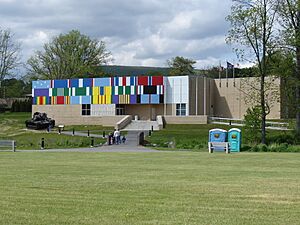Pennsylvania Military Museum facts for kids

Main museum building
|
|
| Lua error in Module:Location_map at line 420: attempt to index field 'wikibase' (a nil value). | |
| Established | 1968 |
|---|---|
| Location | Boalsburg, Pennsylvania |
| Type | Military museum |
The Pennsylvania Military Museum is a special place in Boalsburg, Pennsylvania. It teaches visitors all about the military history of Pennsylvania. The museum first opened its doors in 1968. It is managed by the Pennsylvania Historical and Museum Commission.
Exploring Pennsylvania's Military History
The Pennsylvania Military Museum helps people understand the brave actions of Pennsylvanians in different wars. It shows how soldiers from Pennsylvania have helped protect the country throughout history. The museum has many exhibits that tell these important stories.
Honoring Heroes: Monuments and Memorials
The museum grounds are home to many monuments and memorials. These are special structures built to remember soldiers and military units from Pennsylvania. They help us honor the sacrifices made by these brave individuals.
Some of the memorials include:
- The 28th Division Shrine, which honors a famous Pennsylvania military unit.
- Monuments for different infantry and artillery battalions.
- Memorials dedicated to specific officers and events.
- Walls that remember officers from World War I and World War II.
The museum also displays two large guns. These guns came from the battleship USS Pennsylvania. This ship was an important part of the United States Navy.
Outdoor Displays: Military Vehicles
Outside the main museum building, you can see several real military vehicles. These large machines give you an idea of the equipment used by soldiers.
Some of the vehicles on display include:
- An M4A1(76)W Sherman Tank: This was a very common tank used during World War II.
- An M60A3 Tank: A powerful tank used in later conflicts.
- An M42A1 Duster: A vehicle designed to shoot down enemy aircraft.
- An M59 APC: This vehicle was used to carry soldiers safely on the battlefield.
- An M114A2 155mm Howitzer: A large cannon used to fire shells over long distances.
- A 4.5" Howitzer: Another type of artillery gun.
These outdoor exhibits let you get up close to military history. They show the size and power of the machines used by soldiers.


